Impact of Motivation Strategies on Employee Retention at Waitrose
VerifiedAdded on 2023/06/14
|29
|4960
|94
Report
AI Summary
This report investigates the significance and impact of motivation strategies on employee retention within Waitrose as a talent management strategy. It addresses the conceptual framework of talent management and employee motivation, identifies the motivation strategies Waitrose adopts, and discerns the challenges faced in the absence of effective talent management practices. The methodology includes a deductive research approach, a survey strategy, and a quantitative method, utilizing both primary data collected via questionnaires from 40 Waitrose managers and secondary data from literature reviews. The findings, presented through frequency distribution tables and graphs, are analyzed to understand the relationship between motivation strategies and employee retention, leading to recommendations for Waitrose and implications for further research in the field of talent management.
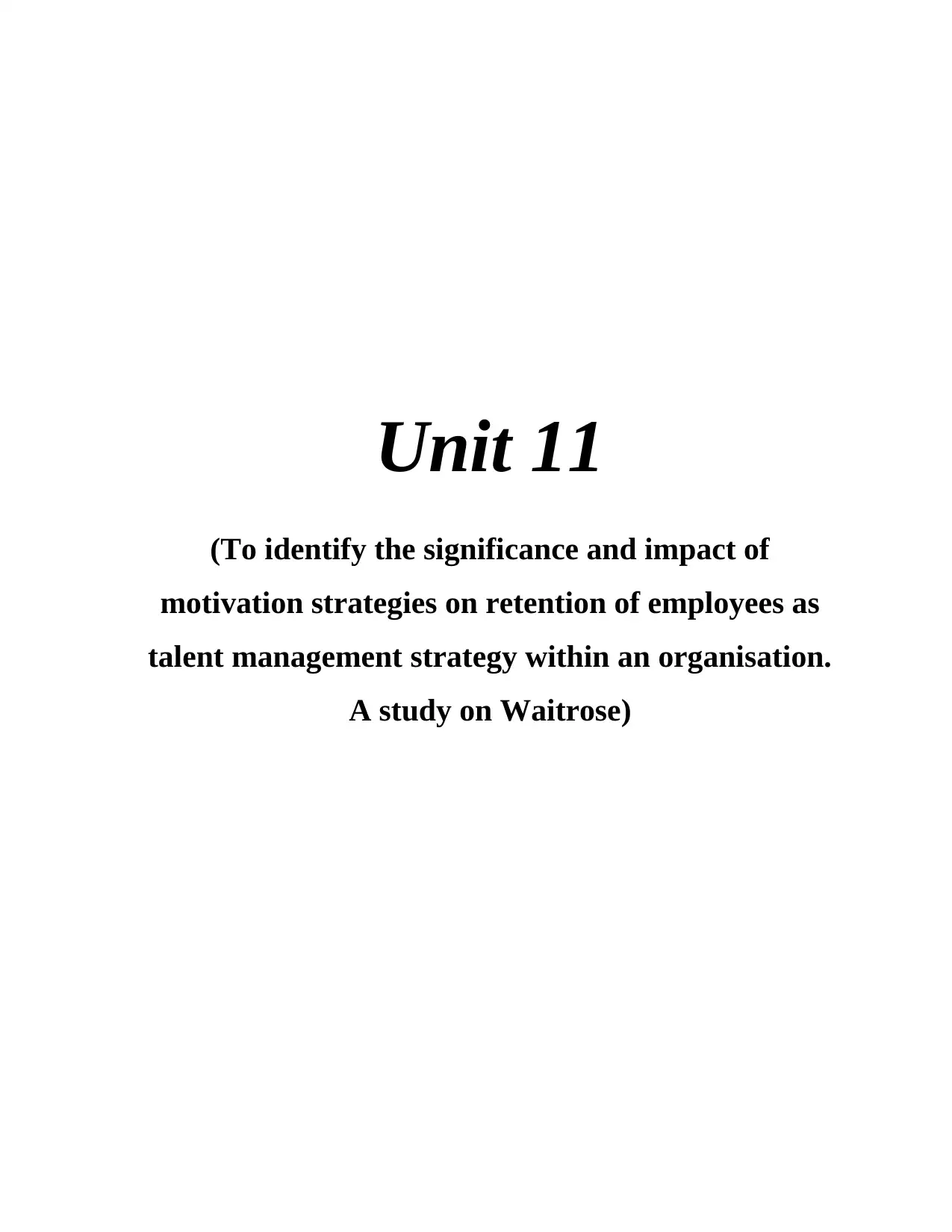
Unit 11
(To identify the significance and impact of
motivation strategies on retention of employees as
talent management strategy within an organisation.
A study on Waitrose)
(To identify the significance and impact of
motivation strategies on retention of employees as
talent management strategy within an organisation.
A study on Waitrose)
Paraphrase This Document
Need a fresh take? Get an instant paraphrase of this document with our AI Paraphraser

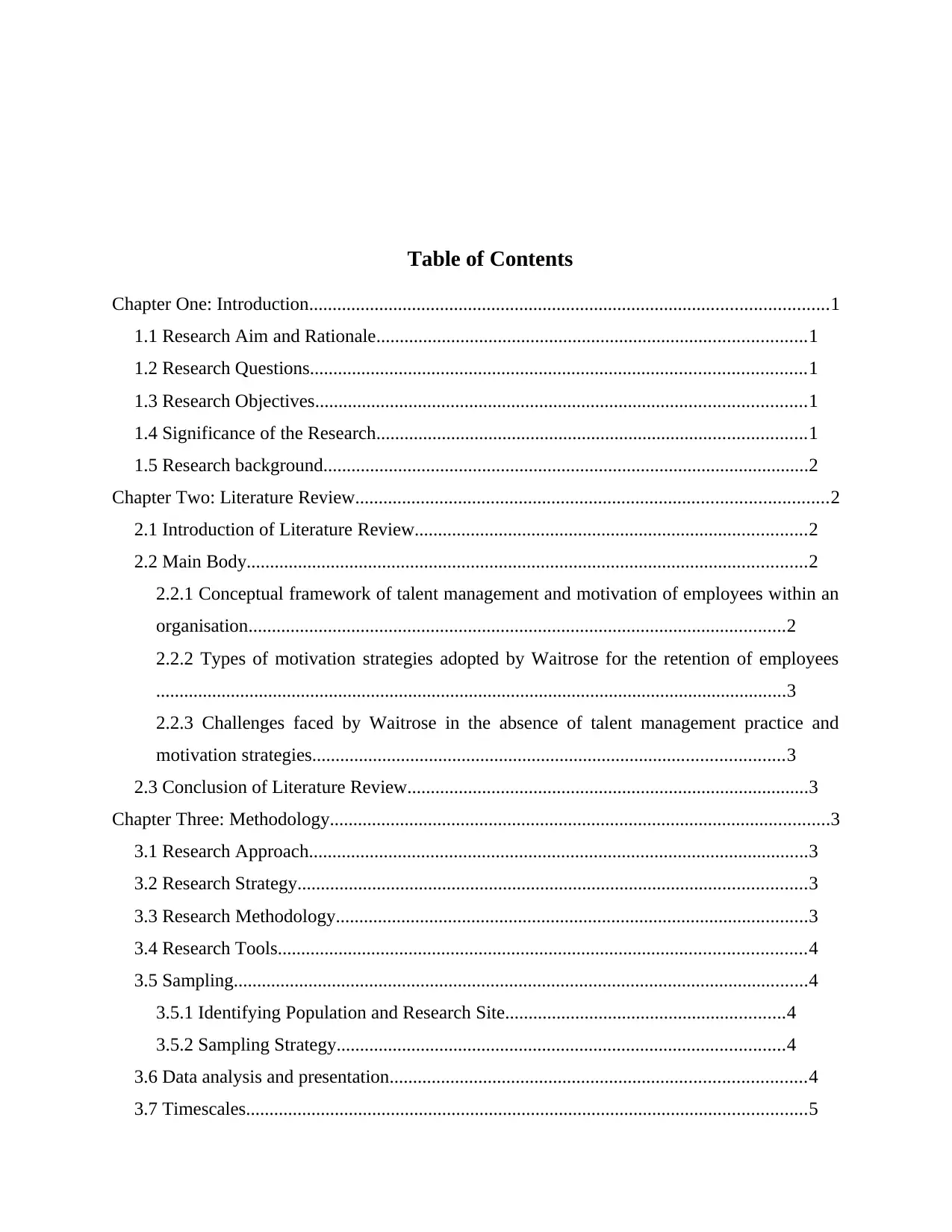
Table of Contents
Chapter One: Introduction...............................................................................................................1
1.1 Research Aim and Rationale............................................................................................1
1.2 Research Questions..........................................................................................................1
1.3 Research Objectives.........................................................................................................1
1.4 Significance of the Research............................................................................................1
1.5 Research background........................................................................................................2
Chapter Two: Literature Review.....................................................................................................2
2.1 Introduction of Literature Review....................................................................................2
2.2 Main Body........................................................................................................................2
2.2.1 Conceptual framework of talent management and motivation of employees within an
organisation...................................................................................................................2
2.2.2 Types of motivation strategies adopted by Waitrose for the retention of employees
.......................................................................................................................................3
2.2.3 Challenges faced by Waitrose in the absence of talent management practice and
motivation strategies.....................................................................................................3
2.3 Conclusion of Literature Review......................................................................................3
Chapter Three: Methodology...........................................................................................................3
3.1 Research Approach...........................................................................................................3
3.2 Research Strategy.............................................................................................................3
3.3 Research Methodology.....................................................................................................3
3.4 Research Tools.................................................................................................................4
3.5 Sampling...........................................................................................................................4
3.5.1 Identifying Population and Research Site............................................................4
3.5.2 Sampling Strategy................................................................................................4
3.6 Data analysis and presentation.........................................................................................4
3.7 Timescales........................................................................................................................5
Chapter One: Introduction...............................................................................................................1
1.1 Research Aim and Rationale............................................................................................1
1.2 Research Questions..........................................................................................................1
1.3 Research Objectives.........................................................................................................1
1.4 Significance of the Research............................................................................................1
1.5 Research background........................................................................................................2
Chapter Two: Literature Review.....................................................................................................2
2.1 Introduction of Literature Review....................................................................................2
2.2 Main Body........................................................................................................................2
2.2.1 Conceptual framework of talent management and motivation of employees within an
organisation...................................................................................................................2
2.2.2 Types of motivation strategies adopted by Waitrose for the retention of employees
.......................................................................................................................................3
2.2.3 Challenges faced by Waitrose in the absence of talent management practice and
motivation strategies.....................................................................................................3
2.3 Conclusion of Literature Review......................................................................................3
Chapter Three: Methodology...........................................................................................................3
3.1 Research Approach...........................................................................................................3
3.2 Research Strategy.............................................................................................................3
3.3 Research Methodology.....................................................................................................3
3.4 Research Tools.................................................................................................................4
3.5 Sampling...........................................................................................................................4
3.5.1 Identifying Population and Research Site............................................................4
3.5.2 Sampling Strategy................................................................................................4
3.6 Data analysis and presentation.........................................................................................4
3.7 Timescales........................................................................................................................5
⊘ This is a preview!⊘
Do you want full access?
Subscribe today to unlock all pages.

Trusted by 1+ million students worldwide
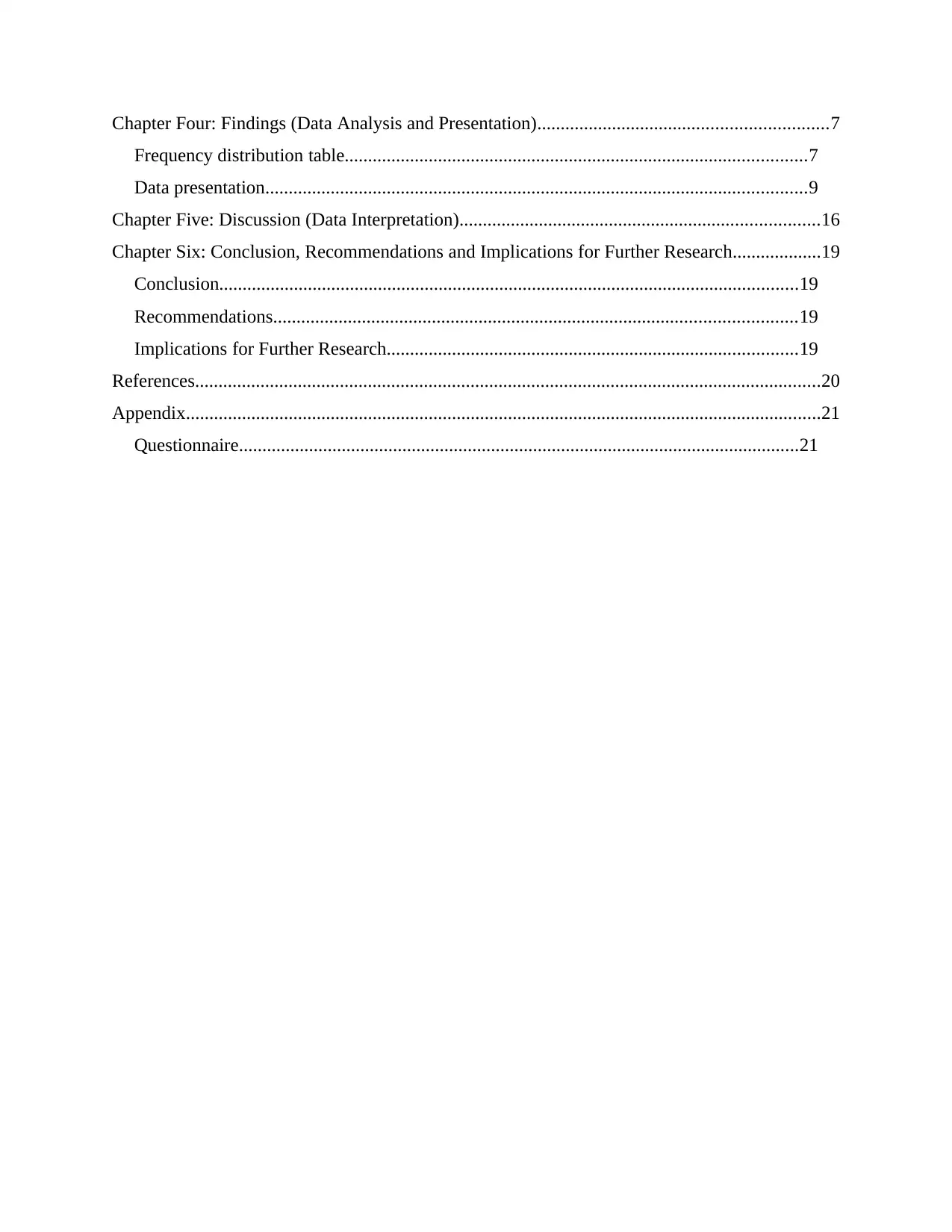
Chapter Four: Findings (Data Analysis and Presentation)..............................................................7
Frequency distribution table...................................................................................................7
Data presentation....................................................................................................................9
Chapter Five: Discussion (Data Interpretation).............................................................................16
Chapter Six: Conclusion, Recommendations and Implications for Further Research...................19
Conclusion............................................................................................................................19
Recommendations................................................................................................................19
Implications for Further Research........................................................................................19
References......................................................................................................................................20
Appendix........................................................................................................................................21
Questionnaire........................................................................................................................21
Frequency distribution table...................................................................................................7
Data presentation....................................................................................................................9
Chapter Five: Discussion (Data Interpretation).............................................................................16
Chapter Six: Conclusion, Recommendations and Implications for Further Research...................19
Conclusion............................................................................................................................19
Recommendations................................................................................................................19
Implications for Further Research........................................................................................19
References......................................................................................................................................20
Appendix........................................................................................................................................21
Questionnaire........................................................................................................................21
Paraphrase This Document
Need a fresh take? Get an instant paraphrase of this document with our AI Paraphraser
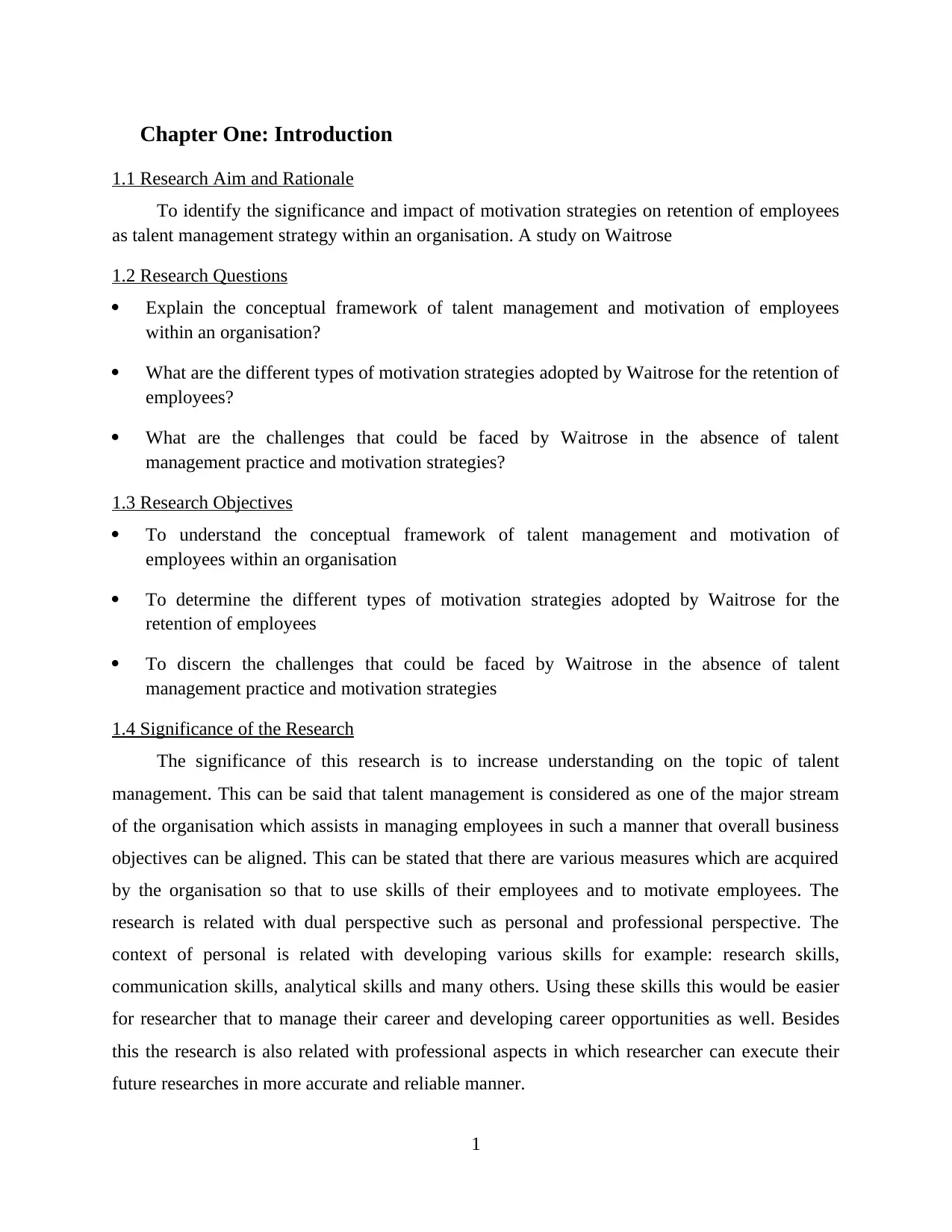
Chapter One: Introduction
1.1 Research Aim and Rationale
To identify the significance and impact of motivation strategies on retention of employees
as talent management strategy within an organisation. A study on Waitrose
1.2 Research Questions
Explain the conceptual framework of talent management and motivation of employees
within an organisation?
What are the different types of motivation strategies adopted by Waitrose for the retention of
employees?
What are the challenges that could be faced by Waitrose in the absence of talent
management practice and motivation strategies?
1.3 Research Objectives
To understand the conceptual framework of talent management and motivation of
employees within an organisation
To determine the different types of motivation strategies adopted by Waitrose for the
retention of employees
To discern the challenges that could be faced by Waitrose in the absence of talent
management practice and motivation strategies
1.4 Significance of the Research
The significance of this research is to increase understanding on the topic of talent
management. This can be said that talent management is considered as one of the major stream
of the organisation which assists in managing employees in such a manner that overall business
objectives can be aligned. This can be stated that there are various measures which are acquired
by the organisation so that to use skills of their employees and to motivate employees. The
research is related with dual perspective such as personal and professional perspective. The
context of personal is related with developing various skills for example: research skills,
communication skills, analytical skills and many others. Using these skills this would be easier
for researcher that to manage their career and developing career opportunities as well. Besides
this the research is also related with professional aspects in which researcher can execute their
future researches in more accurate and reliable manner.
1
1.1 Research Aim and Rationale
To identify the significance and impact of motivation strategies on retention of employees
as talent management strategy within an organisation. A study on Waitrose
1.2 Research Questions
Explain the conceptual framework of talent management and motivation of employees
within an organisation?
What are the different types of motivation strategies adopted by Waitrose for the retention of
employees?
What are the challenges that could be faced by Waitrose in the absence of talent
management practice and motivation strategies?
1.3 Research Objectives
To understand the conceptual framework of talent management and motivation of
employees within an organisation
To determine the different types of motivation strategies adopted by Waitrose for the
retention of employees
To discern the challenges that could be faced by Waitrose in the absence of talent
management practice and motivation strategies
1.4 Significance of the Research
The significance of this research is to increase understanding on the topic of talent
management. This can be said that talent management is considered as one of the major stream
of the organisation which assists in managing employees in such a manner that overall business
objectives can be aligned. This can be stated that there are various measures which are acquired
by the organisation so that to use skills of their employees and to motivate employees. The
research is related with dual perspective such as personal and professional perspective. The
context of personal is related with developing various skills for example: research skills,
communication skills, analytical skills and many others. Using these skills this would be easier
for researcher that to manage their career and developing career opportunities as well. Besides
this the research is also related with professional aspects in which researcher can execute their
future researches in more accurate and reliable manner.
1
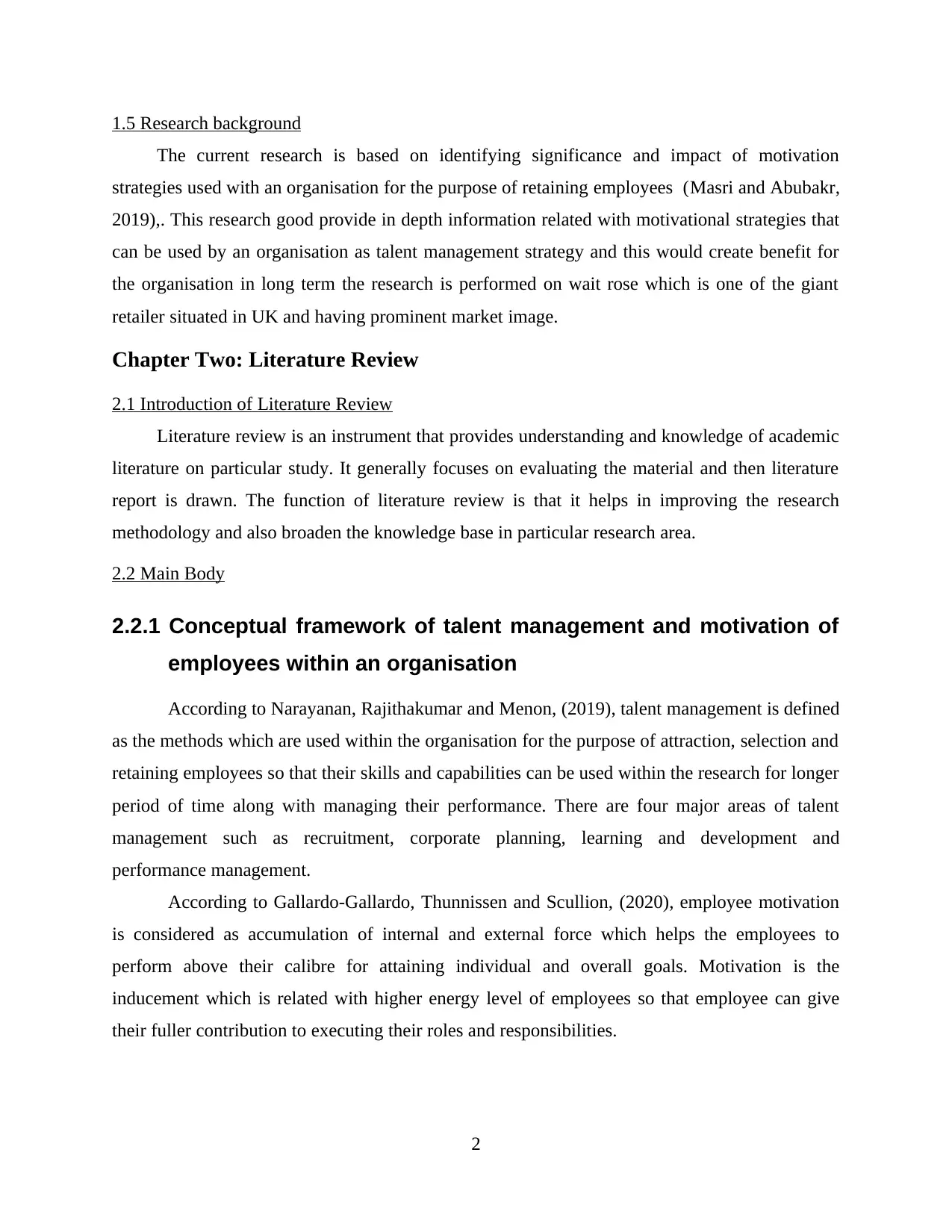
1.5 Research background
The current research is based on identifying significance and impact of motivation
strategies used with an organisation for the purpose of retaining employees (Masri and Abubakr,
2019),. This research good provide in depth information related with motivational strategies that
can be used by an organisation as talent management strategy and this would create benefit for
the organisation in long term the research is performed on wait rose which is one of the giant
retailer situated in UK and having prominent market image.
Chapter Two: Literature Review
2.1 Introduction of Literature Review
Literature review is an instrument that provides understanding and knowledge of academic
literature on particular study. It generally focuses on evaluating the material and then literature
report is drawn. The function of literature review is that it helps in improving the research
methodology and also broaden the knowledge base in particular research area.
2.2 Main Body
2.2.1 Conceptual framework of talent management and motivation of
employees within an organisation
According to Narayanan, Rajithakumar and Menon, (2019), talent management is defined
as the methods which are used within the organisation for the purpose of attraction, selection and
retaining employees so that their skills and capabilities can be used within the research for longer
period of time along with managing their performance. There are four major areas of talent
management such as recruitment, corporate planning, learning and development and
performance management.
According to Gallardo-Gallardo, Thunnissen and Scullion, (2020), employee motivation
is considered as accumulation of internal and external force which helps the employees to
perform above their calibre for attaining individual and overall goals. Motivation is the
inducement which is related with higher energy level of employees so that employee can give
their fuller contribution to executing their roles and responsibilities.
2
The current research is based on identifying significance and impact of motivation
strategies used with an organisation for the purpose of retaining employees (Masri and Abubakr,
2019),. This research good provide in depth information related with motivational strategies that
can be used by an organisation as talent management strategy and this would create benefit for
the organisation in long term the research is performed on wait rose which is one of the giant
retailer situated in UK and having prominent market image.
Chapter Two: Literature Review
2.1 Introduction of Literature Review
Literature review is an instrument that provides understanding and knowledge of academic
literature on particular study. It generally focuses on evaluating the material and then literature
report is drawn. The function of literature review is that it helps in improving the research
methodology and also broaden the knowledge base in particular research area.
2.2 Main Body
2.2.1 Conceptual framework of talent management and motivation of
employees within an organisation
According to Narayanan, Rajithakumar and Menon, (2019), talent management is defined
as the methods which are used within the organisation for the purpose of attraction, selection and
retaining employees so that their skills and capabilities can be used within the research for longer
period of time along with managing their performance. There are four major areas of talent
management such as recruitment, corporate planning, learning and development and
performance management.
According to Gallardo-Gallardo, Thunnissen and Scullion, (2020), employee motivation
is considered as accumulation of internal and external force which helps the employees to
perform above their calibre for attaining individual and overall goals. Motivation is the
inducement which is related with higher energy level of employees so that employee can give
their fuller contribution to executing their roles and responsibilities.
2
⊘ This is a preview!⊘
Do you want full access?
Subscribe today to unlock all pages.

Trusted by 1+ million students worldwide
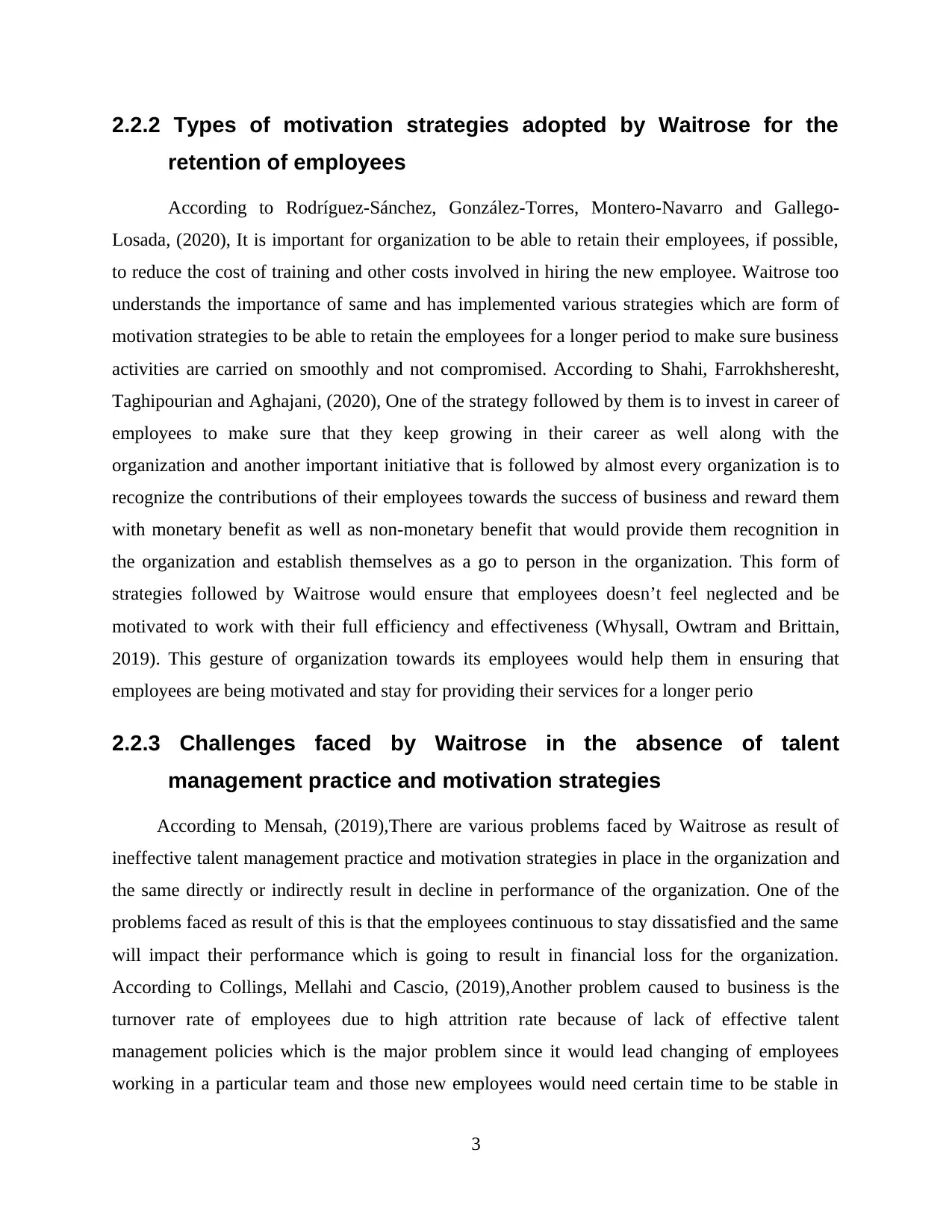
2.2.2 Types of motivation strategies adopted by Waitrose for the
retention of employees
According to Rodríguez-Sánchez, González-Torres, Montero-Navarro and Gallego-
Losada, (2020), It is important for organization to be able to retain their employees, if possible,
to reduce the cost of training and other costs involved in hiring the new employee. Waitrose too
understands the importance of same and has implemented various strategies which are form of
motivation strategies to be able to retain the employees for a longer period to make sure business
activities are carried on smoothly and not compromised. According to Shahi, Farrokhsheresht,
Taghipourian and Aghajani, (2020), One of the strategy followed by them is to invest in career of
employees to make sure that they keep growing in their career as well along with the
organization and another important initiative that is followed by almost every organization is to
recognize the contributions of their employees towards the success of business and reward them
with monetary benefit as well as non-monetary benefit that would provide them recognition in
the organization and establish themselves as a go to person in the organization. This form of
strategies followed by Waitrose would ensure that employees doesn’t feel neglected and be
motivated to work with their full efficiency and effectiveness (Whysall, Owtram and Brittain,
2019). This gesture of organization towards its employees would help them in ensuring that
employees are being motivated and stay for providing their services for a longer perio
2.2.3 Challenges faced by Waitrose in the absence of talent
management practice and motivation strategies
According to Mensah, (2019),There are various problems faced by Waitrose as result of
ineffective talent management practice and motivation strategies in place in the organization and
the same directly or indirectly result in decline in performance of the organization. One of the
problems faced as result of this is that the employees continuous to stay dissatisfied and the same
will impact their performance which is going to result in financial loss for the organization.
According to Collings, Mellahi and Cascio, (2019),Another problem caused to business is the
turnover rate of employees due to high attrition rate because of lack of effective talent
management policies which is the major problem since it would lead changing of employees
working in a particular team and those new employees would need certain time to be stable in
3
retention of employees
According to Rodríguez-Sánchez, González-Torres, Montero-Navarro and Gallego-
Losada, (2020), It is important for organization to be able to retain their employees, if possible,
to reduce the cost of training and other costs involved in hiring the new employee. Waitrose too
understands the importance of same and has implemented various strategies which are form of
motivation strategies to be able to retain the employees for a longer period to make sure business
activities are carried on smoothly and not compromised. According to Shahi, Farrokhsheresht,
Taghipourian and Aghajani, (2020), One of the strategy followed by them is to invest in career of
employees to make sure that they keep growing in their career as well along with the
organization and another important initiative that is followed by almost every organization is to
recognize the contributions of their employees towards the success of business and reward them
with monetary benefit as well as non-monetary benefit that would provide them recognition in
the organization and establish themselves as a go to person in the organization. This form of
strategies followed by Waitrose would ensure that employees doesn’t feel neglected and be
motivated to work with their full efficiency and effectiveness (Whysall, Owtram and Brittain,
2019). This gesture of organization towards its employees would help them in ensuring that
employees are being motivated and stay for providing their services for a longer perio
2.2.3 Challenges faced by Waitrose in the absence of talent
management practice and motivation strategies
According to Mensah, (2019),There are various problems faced by Waitrose as result of
ineffective talent management practice and motivation strategies in place in the organization and
the same directly or indirectly result in decline in performance of the organization. One of the
problems faced as result of this is that the employees continuous to stay dissatisfied and the same
will impact their performance which is going to result in financial loss for the organization.
According to Collings, Mellahi and Cascio, (2019),Another problem caused to business is the
turnover rate of employees due to high attrition rate because of lack of effective talent
management policies which is the major problem since it would lead changing of employees
working in a particular team and those new employees would need certain time to be stable in
3
Paraphrase This Document
Need a fresh take? Get an instant paraphrase of this document with our AI Paraphraser
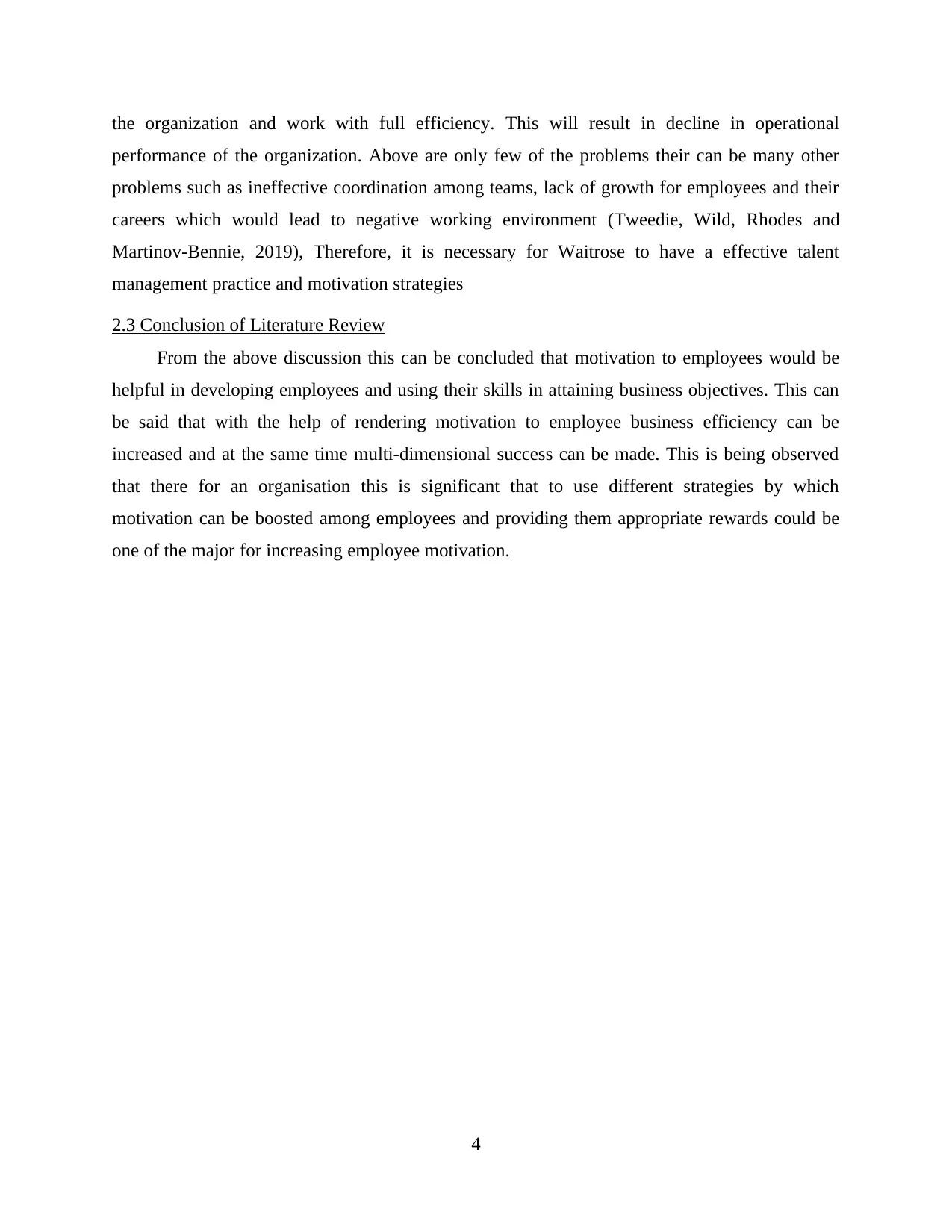
the organization and work with full efficiency. This will result in decline in operational
performance of the organization. Above are only few of the problems their can be many other
problems such as ineffective coordination among teams, lack of growth for employees and their
careers which would lead to negative working environment (Tweedie, Wild, Rhodes and
Martinov‐Bennie, 2019), Therefore, it is necessary for Waitrose to have a effective talent
management practice and motivation strategies
2.3 Conclusion of Literature Review
From the above discussion this can be concluded that motivation to employees would be
helpful in developing employees and using their skills in attaining business objectives. This can
be said that with the help of rendering motivation to employee business efficiency can be
increased and at the same time multi-dimensional success can be made. This is being observed
that there for an organisation this is significant that to use different strategies by which
motivation can be boosted among employees and providing them appropriate rewards could be
one of the major for increasing employee motivation.
4
performance of the organization. Above are only few of the problems their can be many other
problems such as ineffective coordination among teams, lack of growth for employees and their
careers which would lead to negative working environment (Tweedie, Wild, Rhodes and
Martinov‐Bennie, 2019), Therefore, it is necessary for Waitrose to have a effective talent
management practice and motivation strategies
2.3 Conclusion of Literature Review
From the above discussion this can be concluded that motivation to employees would be
helpful in developing employees and using their skills in attaining business objectives. This can
be said that with the help of rendering motivation to employee business efficiency can be
increased and at the same time multi-dimensional success can be made. This is being observed
that there for an organisation this is significant that to use different strategies by which
motivation can be boosted among employees and providing them appropriate rewards could be
one of the major for increasing employee motivation.
4
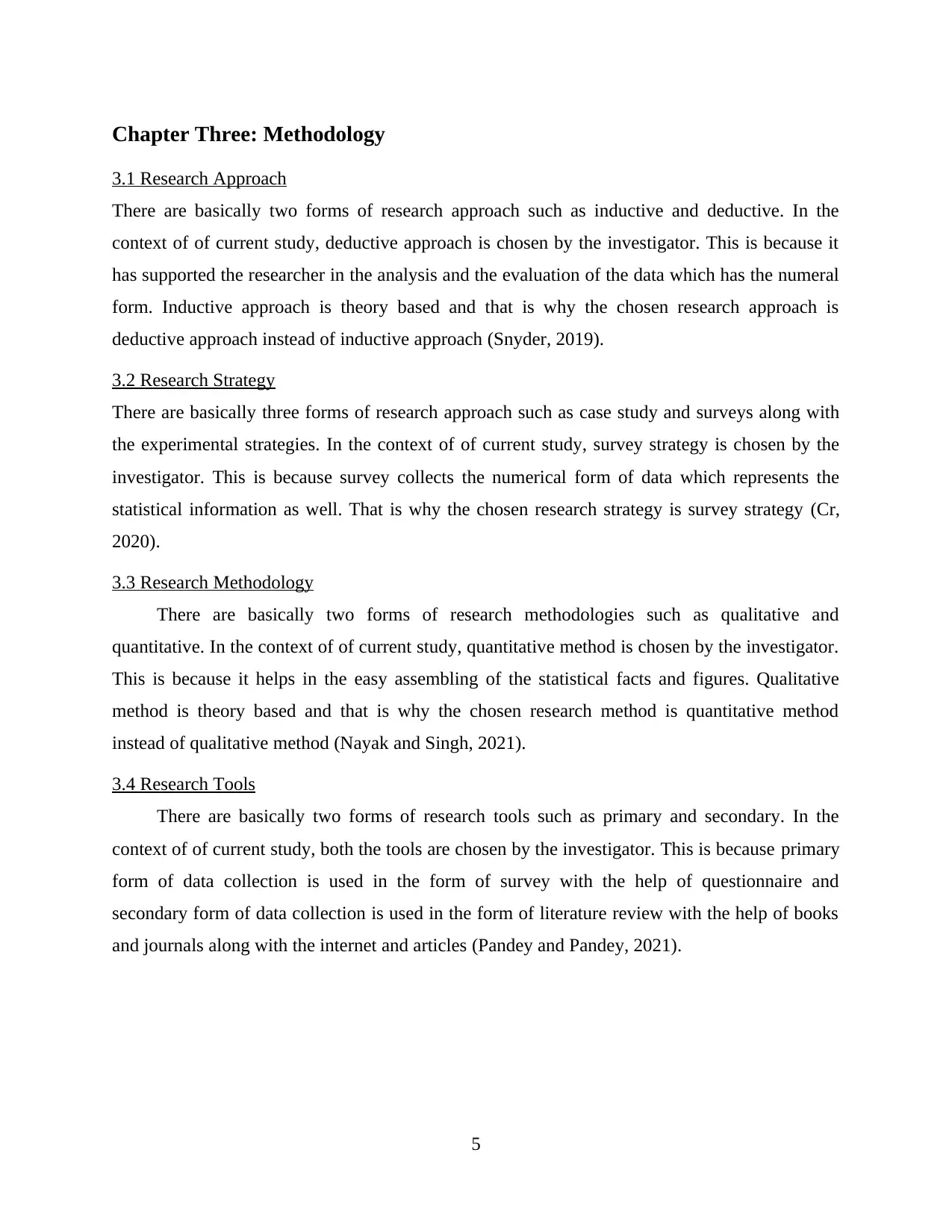
Chapter Three: Methodology
3.1 Research Approach
There are basically two forms of research approach such as inductive and deductive. In the
context of of current study, deductive approach is chosen by the investigator. This is because it
has supported the researcher in the analysis and the evaluation of the data which has the numeral
form. Inductive approach is theory based and that is why the chosen research approach is
deductive approach instead of inductive approach (Snyder, 2019).
3.2 Research Strategy
There are basically three forms of research approach such as case study and surveys along with
the experimental strategies. In the context of of current study, survey strategy is chosen by the
investigator. This is because survey collects the numerical form of data which represents the
statistical information as well. That is why the chosen research strategy is survey strategy (Cr,
2020).
3.3 Research Methodology
There are basically two forms of research methodologies such as qualitative and
quantitative. In the context of of current study, quantitative method is chosen by the investigator.
This is because it helps in the easy assembling of the statistical facts and figures. Qualitative
method is theory based and that is why the chosen research method is quantitative method
instead of qualitative method (Nayak and Singh, 2021).
3.4 Research Tools
There are basically two forms of research tools such as primary and secondary. In the
context of of current study, both the tools are chosen by the investigator. This is because primary
form of data collection is used in the form of survey with the help of questionnaire and
secondary form of data collection is used in the form of literature review with the help of books
and journals along with the internet and articles (Pandey and Pandey, 2021).
5
3.1 Research Approach
There are basically two forms of research approach such as inductive and deductive. In the
context of of current study, deductive approach is chosen by the investigator. This is because it
has supported the researcher in the analysis and the evaluation of the data which has the numeral
form. Inductive approach is theory based and that is why the chosen research approach is
deductive approach instead of inductive approach (Snyder, 2019).
3.2 Research Strategy
There are basically three forms of research approach such as case study and surveys along with
the experimental strategies. In the context of of current study, survey strategy is chosen by the
investigator. This is because survey collects the numerical form of data which represents the
statistical information as well. That is why the chosen research strategy is survey strategy (Cr,
2020).
3.3 Research Methodology
There are basically two forms of research methodologies such as qualitative and
quantitative. In the context of of current study, quantitative method is chosen by the investigator.
This is because it helps in the easy assembling of the statistical facts and figures. Qualitative
method is theory based and that is why the chosen research method is quantitative method
instead of qualitative method (Nayak and Singh, 2021).
3.4 Research Tools
There are basically two forms of research tools such as primary and secondary. In the
context of of current study, both the tools are chosen by the investigator. This is because primary
form of data collection is used in the form of survey with the help of questionnaire and
secondary form of data collection is used in the form of literature review with the help of books
and journals along with the internet and articles (Pandey and Pandey, 2021).
5
⊘ This is a preview!⊘
Do you want full access?
Subscribe today to unlock all pages.

Trusted by 1+ million students worldwide
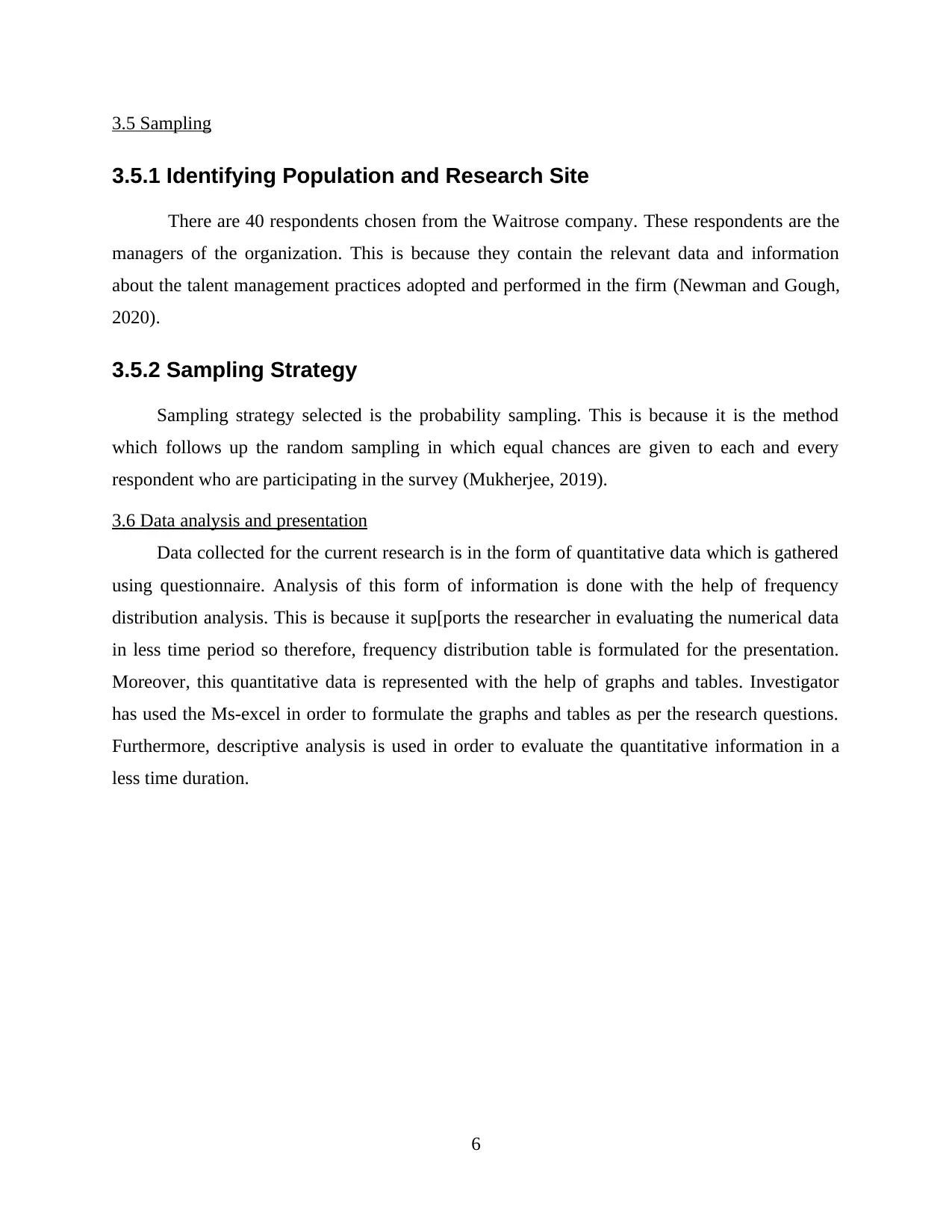
3.5 Sampling
3.5.1 Identifying Population and Research Site
There are 40 respondents chosen from the Waitrose company. These respondents are the
managers of the organization. This is because they contain the relevant data and information
about the talent management practices adopted and performed in the firm (Newman and Gough,
2020).
3.5.2 Sampling Strategy
Sampling strategy selected is the probability sampling. This is because it is the method
which follows up the random sampling in which equal chances are given to each and every
respondent who are participating in the survey (Mukherjee, 2019).
3.6 Data analysis and presentation
Data collected for the current research is in the form of quantitative data which is gathered
using questionnaire. Analysis of this form of information is done with the help of frequency
distribution analysis. This is because it sup[ports the researcher in evaluating the numerical data
in less time period so therefore, frequency distribution table is formulated for the presentation.
Moreover, this quantitative data is represented with the help of graphs and tables. Investigator
has used the Ms-excel in order to formulate the graphs and tables as per the research questions.
Furthermore, descriptive analysis is used in order to evaluate the quantitative information in a
less time duration.
6
3.5.1 Identifying Population and Research Site
There are 40 respondents chosen from the Waitrose company. These respondents are the
managers of the organization. This is because they contain the relevant data and information
about the talent management practices adopted and performed in the firm (Newman and Gough,
2020).
3.5.2 Sampling Strategy
Sampling strategy selected is the probability sampling. This is because it is the method
which follows up the random sampling in which equal chances are given to each and every
respondent who are participating in the survey (Mukherjee, 2019).
3.6 Data analysis and presentation
Data collected for the current research is in the form of quantitative data which is gathered
using questionnaire. Analysis of this form of information is done with the help of frequency
distribution analysis. This is because it sup[ports the researcher in evaluating the numerical data
in less time period so therefore, frequency distribution table is formulated for the presentation.
Moreover, this quantitative data is represented with the help of graphs and tables. Investigator
has used the Ms-excel in order to formulate the graphs and tables as per the research questions.
Furthermore, descriptive analysis is used in order to evaluate the quantitative information in a
less time duration.
6
Paraphrase This Document
Need a fresh take? Get an instant paraphrase of this document with our AI Paraphraser
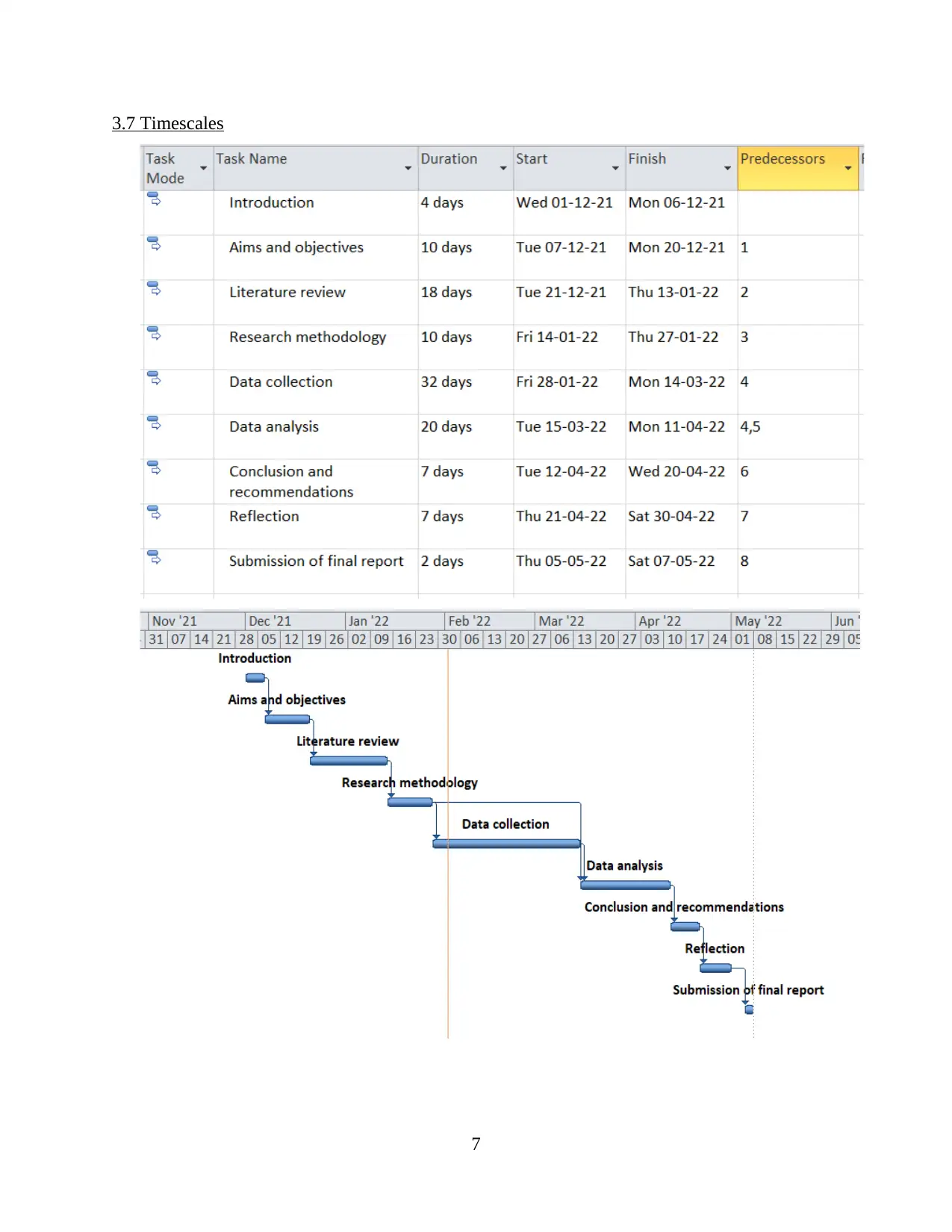
3.7 Timescales
7
7
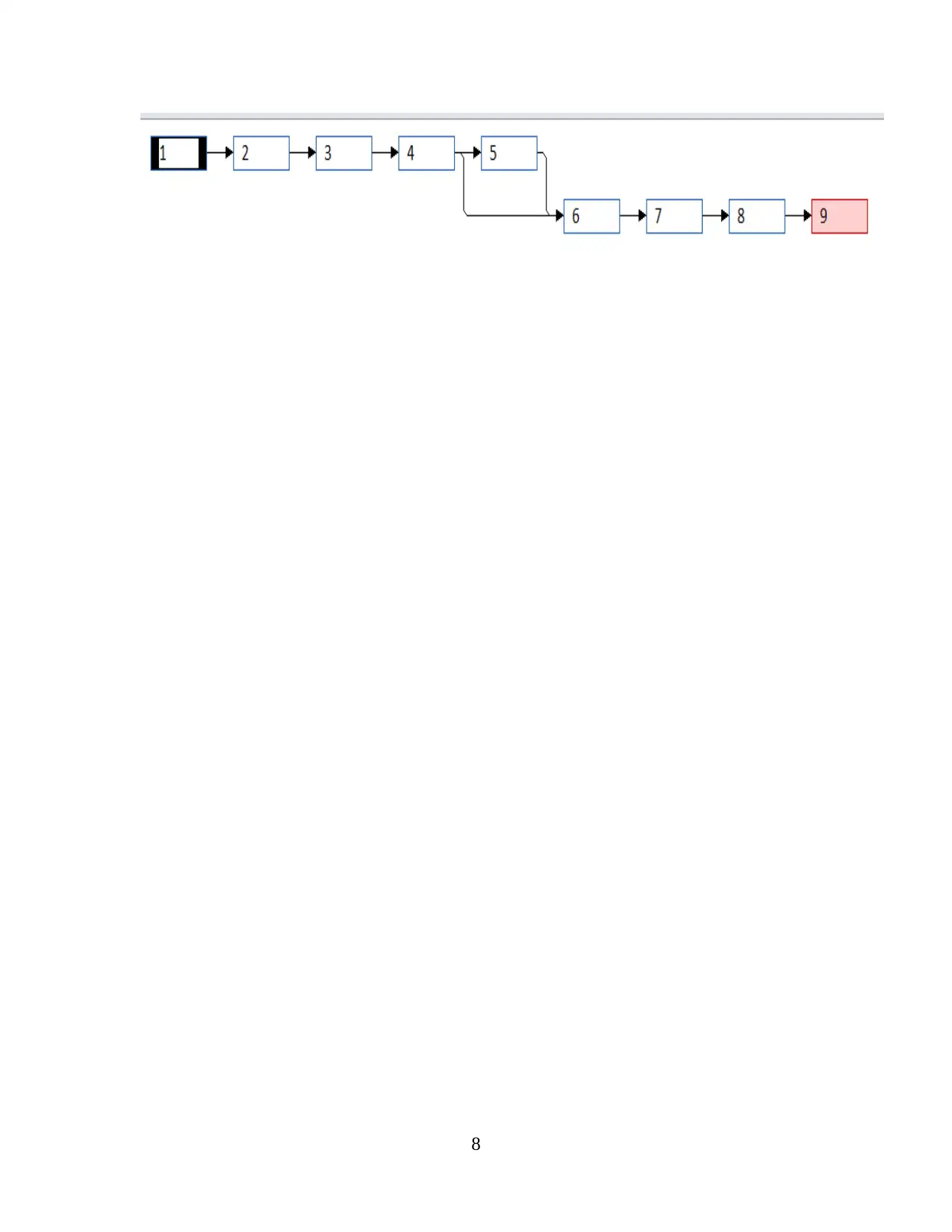
8
⊘ This is a preview!⊘
Do you want full access?
Subscribe today to unlock all pages.

Trusted by 1+ million students worldwide
1 out of 29
Related Documents
Your All-in-One AI-Powered Toolkit for Academic Success.
+13062052269
info@desklib.com
Available 24*7 on WhatsApp / Email
![[object Object]](/_next/static/media/star-bottom.7253800d.svg)
Unlock your academic potential
Copyright © 2020–2025 A2Z Services. All Rights Reserved. Developed and managed by ZUCOL.




